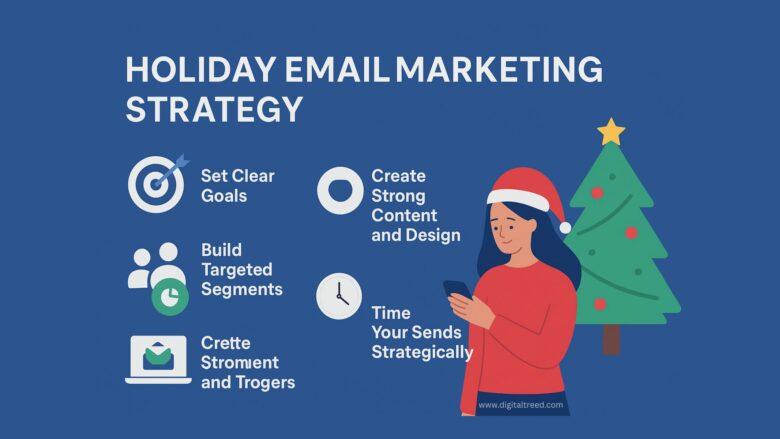Holiday sales drive the biggest revenue spikes of the year. Email remains one of the most effective ways to reach customers during this period.
The challenge is to cut through crowded inboxes and deliver messages that drive action. A well-planned strategy makes the difference between average results and maximum return on investment.
Set Clear Goals
You need measurable objectives before you write a single subject line. Goals keep campaigns focused and help you track performance. Define what success means for your business.
- Increase online sales by a percentage compared to last year.
- Grow your average order value by promoting bundles or upsells.
- Expand your subscriber base with referral offers.
- Drive in-store traffic with exclusive promotions.
Align your goals with business priorities. If you want repeat purchases, focus on loyalty incentives. If you want new customers, build referral campaigns. Every email should move you closer to a target.
Build Targeted Segments
Generic blasts lead to low engagement. Segmentation allows you to send tailored messages to groups that share traits or behaviors. This boosts relevance and conversion rates.
Start with simple divisions. Segment by purchase history, location, or level of engagement. Go further by creating groups based on interests, browsing behavior, or loyalty status. Customers who purchased winter gear last year respond well to early holiday promotions for similar items.
Effective segmentation reduces wasted sends. It helps you avoid sending discounts to customers who would have paid full price. Instead, you direct offers where they drive incremental revenue.
Create Strong Content and Design
Your content determines whether subscribers open, click, and purchase. Subject lines should be clear and benefit-driven. Use urgency sparingly, but communicate value quickly. Inside the email, combine short copy with visuals that guide the reader toward your offer.
Look at Black Friday sale email examples from leading retailers. You will notice bold headlines, clear calls to action, and limited distractions. Each element points toward conversion. Minimal design often performs better than cluttered layouts.
Make your offers specific. Instead of saying “Holiday Deals,” highlight “40% Off Winter Jackets Today.” Specificity creates clarity and urgency. Include clear buttons that lead directly to product pages. Reduce friction at every step.
Time Your Sends Strategically
Timing influences revenue as much as content. Customers receive dozens of emails during the holidays. Your message must arrive when they are ready to buy.
- Send early teasers to build anticipation.
- Schedule reminders for cart abandoners within 24 hours.
- Use last-minute deals for shoppers who wait until the final days.
- Spread sends across different times of day to find peak engagement windows.
Analyze previous campaigns to identify patterns. Some audiences respond well to morning sends, while others engage late at night. Test and adjust rather than assume.
Leverage Automation and Triggers
Manual sending wastes time and limits scale. Automated workflows let you respond instantly to customer behavior. Common triggers include:
- Cart abandonment emails.
- Post-purchase upsells.
- Re-engagement campaigns for inactive subscribers.
- Personalized recommendations based on browsing.
These triggered emails usually outperform standard campaigns. They reach customers with relevant content at the right time. Automation frees you to focus on strategy while the system handles execution.
Test, Measure, and Refine
You cannot maximize ROI without data. Testing shows you what works and what fails. Measure each element of your campaign: subject lines, offers, designs, and timing.
Run A/B tests on single variables. Compare two subject lines or two discount levels. Use the results to inform future sends. Track open rates, click-through rates, and revenue per email. Conversion rate is the most important metric. Revenue tells you if engagement leads to sales.
Do not stop after one test. Continuous iteration improves performance over time. Small gains in open or click rates add up across millions of holiday sends.
Focus on Deliverability
Even the best content fails if your emails land in spam folders. Strong deliverability protects ROI. Maintain a clean list by removing inactive addresses. Avoid spammy language in subject lines. Authenticate your domain to build trust with providers.
Monitor bounce rates and complaints. High complaints harm sender reputation. Encourage subscribers to white-list your address. Offer clear unsubscribe options to reduce frustration. Protecting deliverability ensures your investment in content and design pays off.
Align With the Customer Journey
Holiday shoppers move quickly from awareness to purchase. Email should support every step. Early campaigns raise awareness of deals. Mid-season sends drive conversions. Post-holiday emails encourage gift card redemptions or exchanges.
Map your messages to the customer journey. When you align email with buying behavior, you reduce wasted effort and maximize lifetime value.
Conclusion
Holiday email marketing requires precision. Set goals, segment wisely, create strong content, and time your sends carefully. Support campaigns with automation, testing, and deliverability practices. Align your emails with customer behavior from start to finish.
When executed well, email drives unmatched ROI during the busiest shopping season. Use data, discipline, and proven practices to ensure your campaigns deliver maximum results.

Leave a Reply